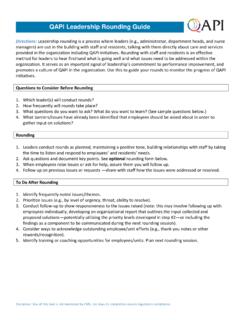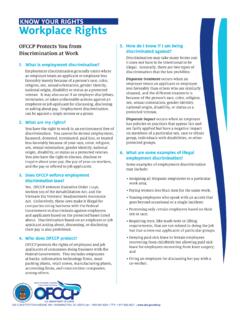Transcription of Startup Employee Stock Options Plans (ESOPs) - Accion
1 Startup Employee Stock Options Plans (ESOPs) Overview and Best Practices Table of Contents Part I: Intro to Options Plans What is an ESOP? What is an Option? Lifecycle of a Startup ESOP Common Terms in an Options Package Why Issue Options to Employees? A Defining Characteristic of Startup Culture A Necessary Part of the Capital Structure When to Create an ESOP? Communicating Options to Employees: % versus $ Part II: How Much to Grant Two Approaches The Top-Down Process 1. How Much Equity to Set Aside in the ESOP? 2. A Typical Distribution Schedule The Bottom-Up Process 1. Segment Your Human Resources 2. Establish Pay Multipliers for Each Role 3. Determine the Dollar Value of the Options Grant 4. Determine the Current Share Price 5. Calculate the Options Grant An Example: Hiring a CTO Important Takeaways Part III: The Fine Print Terms Strike Price Vesting Schedule The Cliff Example: Standard Vesting w/ a Cliff Vesting in a Liquidity Event Exercising Options Tax Considerations Legal Advice Part IV: ESOPs for the Long Term Retention Grants Discretionary Grants Social Impact Considerations Options Modeling Overview Options Modeling A Detailed Example Part V: Resources & Further Reading INTRO TO Options Plans Part I What is an ESOP?
2 An Employee Stock Options plan (ESOP) An allocation of shares that will be granted to employees in the future in the form of Stock Options How much equity should we set aside for employees? A plan for how these Options will be distributed: How many shares will individual employees receive? What terms will govern these grants? The plan is as important as the allocation! What is an Option? Why do Options have intrinsic value? A effective form of equity ownership A locked-in price for shares How do startups use Options ? To bring in founding team members who are not co-founders To recruit, compensate and retain early employees To allow later employees to share in the company s long-term upside Terminology: This presentation uses Options generally to refer to several types of securities that are often issued to Startup employees to provide for effective equity ownership, including: - Stock Options (the right to buy common Stock a set strike price) -Restricted Stock (common Stock issued early on to top employees) -Restricted Stock units (a promise to issue common Stock in the future) Appropriate use of these securities will vary based on local regulatory and tax considerations.
3 An option is a right (but not an obligation) to purchase a quantity of a company s Stock at a set price for a certain period of time Lifecycle of a Startup ESOP Founders and early investors create an ESOP by setting aside a percentage of shares to be granted to future employees Management and the Board of Directors issue these shares to employees as Options packages granted for hiring, promotion and retention Employees receive all of their Options upfront, but the company maintains a right to force forfeit that diminishes over time through a process called vesting Options are exercised by employees when the company is acquired or taken public. The Employee pays the strike price to acquire the shares, but those shares are now marketable at a higher value Common Terms in an Options Package Number of Shares The total number of Options granted to an Employee , and therefore the maximum number of shares that Employee has access to Strike Price The price the Employee must pay to purchase each share if and when the Employee chooses to exercise the option Vesting Schedule The timeline over which the Options become wholly owned and exercisable by the Employee (no longer subject to repurchase by the company) Cliff Period The trial period during which no vesting occurs.
4 In this period vesting accrues, but the total effect of this vesting is realized immediately after the cliff Expiration Date The last date on which the Options may be exercised and converted into common shares by the Employee We will discuss the mechanics in further detail, but these basic terms are helpful to understanding Options grants Why Issue Options to Employees? Attract Talent: Options can be used to attract top recruits, particularly engineers, product managers and other technical team members Retain Employees: Options vest over several years, creating strong incentives for employees to remain employees Align Incentives: by making employees equity owners, Options align incentives with the long-term goals of the company Reward Value Creation: Options reward tangible contributions that increase corporate valuation by giving employees a slice of that value Encourage Long-term Thinking: Options typically pay off only in a liquidity event or exit, and thus push employees to build the company for long-term success The defining difference between Silicon Valley companies and almost every other industry in the is the virtually universal practice among tech companies of distributing meaningful equity (usually in the form of Stock Options ) to ordinary employees.
5 A Defining Characteristic of Startup Culture Steven Johnson, Technology Writer Startups are a unique case. Unlike at larger corporations, Employee ownership is an essential element of Startup communities and culture As high-risk/high-reward enterprises, startups use Options to align Employee compensation with the risk-prone mentality of the business Startups seeking to achieve a big exit use Options to align all employees to drive toward this desired outcome A Necessary Part of the Capital Structure Venture capitalists require ESOPs. For many VCs, establishing a Stock option pool is a prerequisite to closing a deal In an industry where Options are ubiquitous, startups are compelled to offer Options packages to compete for top talent with other venture-backed companies When operating budgets are tight, competitive compensation packages may not be possible; Options can be used to incentivize employees instead of cash I can't think of a term sheet that we have issued that didn't have a specific provision for Employee equity.
6 Fred Wilson, Union Square Ventures When to Create an ESOP? Stage Considerations Takeaway Pre-seed Founders focused on traction (often too busy for an ESOP). Key employees are given equity/ Options on an ad hoc basis ESOP not necessary, but it can be helpful to sanity check how much equity you are giving away to early hires Seed First outside financing round. Investors either angel or institutional; institutional investors will require an ESOP Seed rounds can be closed without an ESOP; the benefit to doing so is that seed investors then share in the dilution Early-VC The first true VC round. Investors will require an ESOP in place. New hires will be seek large equity grants. ESOP must be created (to appease investors and to serve as a guideline for the size of new-hire Options grants) Late-VC Flush with capital, startups at this stage begin to steadily ramp-up hiring, yet employees still want equity Important to have standardized the ESOP and the amount of equity granted to new hires at each level Growth Company is aggressively pursuing growth and hiring; likely to have exhausted most of the ESOP Most of the ESOP is gone, but shares remaining are more valuable; use them to allow new hires to share in the upside Make Employee equity allocations and set up an ESOP sometime between the pre-seed and early-VC stage Communicating Options to Employees: % versus $ Options packages can be communicated either as (1) a percentage of ownership in the company, or (2) a dollar value based on the current valuation.
7 We encourage the latter when possible % $ We are granting you Options equivalent to of the company s equity Considerations: At an early stage, the only way to communicate Options grants given no true valuation of the company Hard for employees to grasp what they are really getting ( seems too little ) Invites a negotiation about what percent of the company an Employee really deserves We are granting you Options equivalent to $200,000 of company Stock Considerations: Once valuation is established, highly effective way to communicate the true value of an Options grant Easy for employees to grasp what they are really getting ( $200,000 is a lot ) Grounds negotiations in a discussion about concrete dollar amounts, rather than a percent of the company Note: Although we recommend communicating Options packages as a dollar value, we do not suggest refusing employees information about their effective percentage ownership; all Options holders are entitled to this information, and to refuse would be unethical.
8 HOW MUCH TO GRANT Part II Two Approaches In reality, creating an ESOP will require a combination of top-down and bottom-up planning Top Down Bottom Up Decide the total amount of equity to be granted; allocate these shares to employees over time Decide the appropriate size of individual equity grants by position; issue these shares as employees are hired The Top-Down Process how much equity to set aside for non-founder employees a schedule of how this equity will be distributed over time 1. How Much Equity to Set Aside in the ESOP? Founders are top managers with functional roles that are not redundant DNA of the company is in a non-technical industry; no technology emphasis Geographic focus is on a region that is not considered a Startup hub Hiring needs are primarily administrative or back-office team members <15% 20% 25% Generally non-founder employees get 15-20% of the company, with some companies issuing up to 25% (and a current trend toward bigger ESOPs) Founders are top mangers, but hire others to fill key technical or functional roles DNA of the company is in applying technology to a non-technical industry Geographic focus is either wholly or partially in a Startup hub Hiring needs are primarily sales and marketing team members Founders are not top managers in the business, or plan to step aside DNA of the company is in technology, engineering, or data science Geographic focus is in a leading Startup hub such as SF, NYC or Boston Hiring needs are primarily engineering, development, or technical team members There are no hard and fast rules, but by looking your company s founders, its DNA, its geographic focus, and its hiring needs you can begin to benchmark how much equity to set aside for the ESOP 2.
9 A Typical Distribution Schedule Seniority Equity Allocation First 10 Employees 10% Next 20 Employees 5% Next 50 Employees 5% Early-stage equity grants are always a negotiation, but generally: CTO: 1-5% Key Developer or Engineer: 1-2% Other Functional Team Member: No non-founding member of the senior team should receive over 10% The Bottom-Up Process your human resources pay multipliers for each job function the dollar value of an Options grant the current share price Options grants 1. Segment Your Human Resources Segment Roles Award in % or $? Founders Co-Founders % Founding Team Technical & Product % Early-Stage Hires Senior Team (C-Level) $ Directors / VPs $ Functional / Technical Team $ Support Team $ Think about the early-stage team in three segments Founders: the founding partners in the business Founding Team: the people you hire to build your product Early-Stage Hires: the team you build as you raise capital As early as possible, begin communicating Options grants in terms of dollars rather than percentages 2.
10 Establish Pay Multipliers for Each Role Segment Roles Award in % or $? Options Multiplier (Multiple of Salary) Founders Co-Founders % -- Founding Team Technical & Product % Negotiated Early-Stage Hires Senior Team (C-Level) $ base salary Directors / VPs $ base salary Functional / Technical Team $ base salary Support Team $ base salary After segmenting the early-stage team, establish a standardized multiple of base salary to be granted as an option package These ranges provide a ballpark grant for each role Get away from actively negotiating packages with employees Be transparent about this methodology Source: This range of multiples was provided by Fred Wilson of Union Square Ventures, which he created in collaboration with a leading HR consulting firm. 3. Determine the Dollar Value of the Options Grant Employee Base Salary = x Options Multiplier Dollar Value of Options Grant Base Salary as negotiated with the Employee at the time of hire or promotion Options Multiplier is decided based on the Employee s role in the HR segmentation schedule 4.





